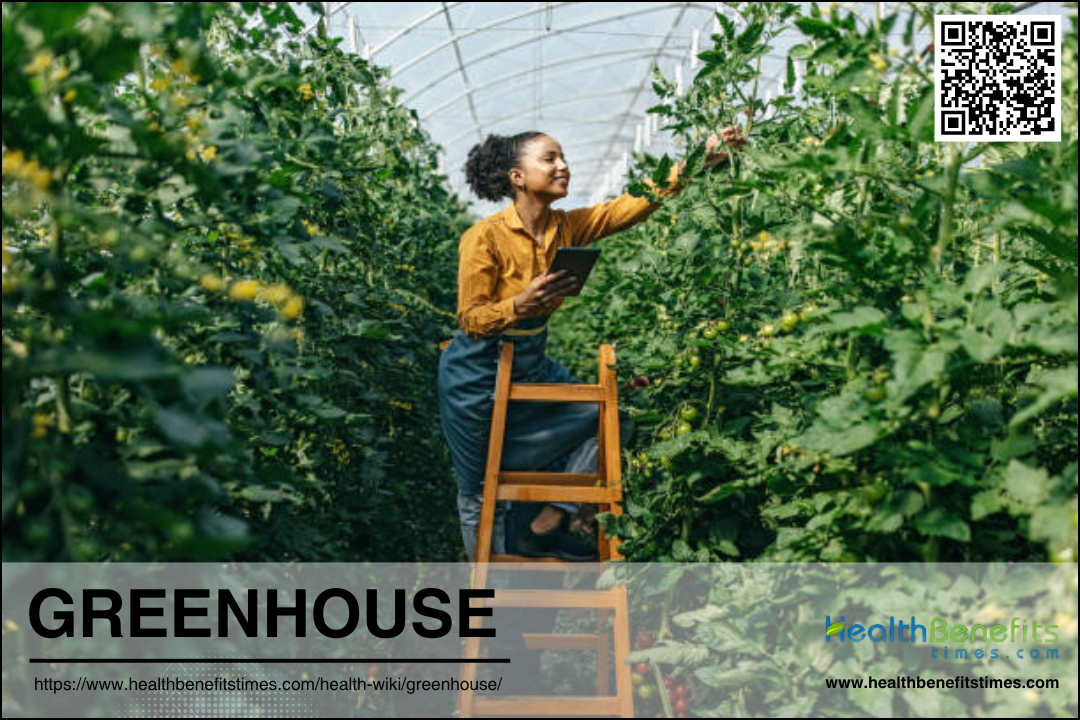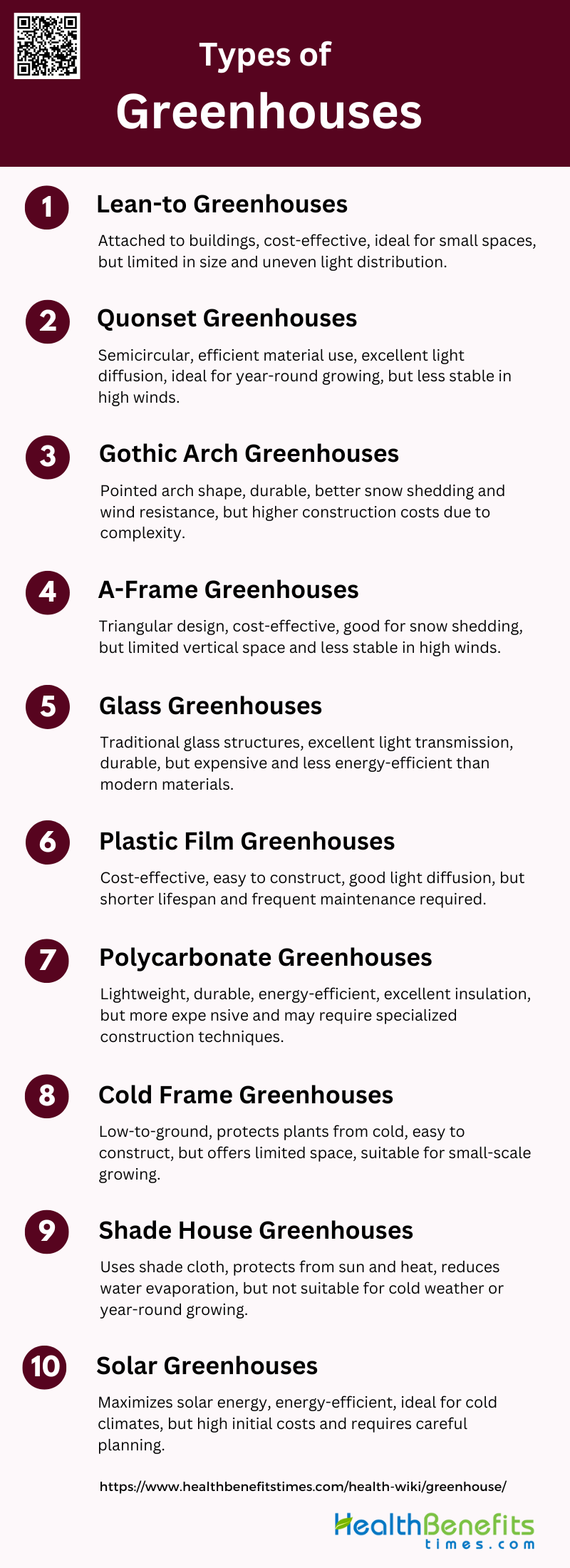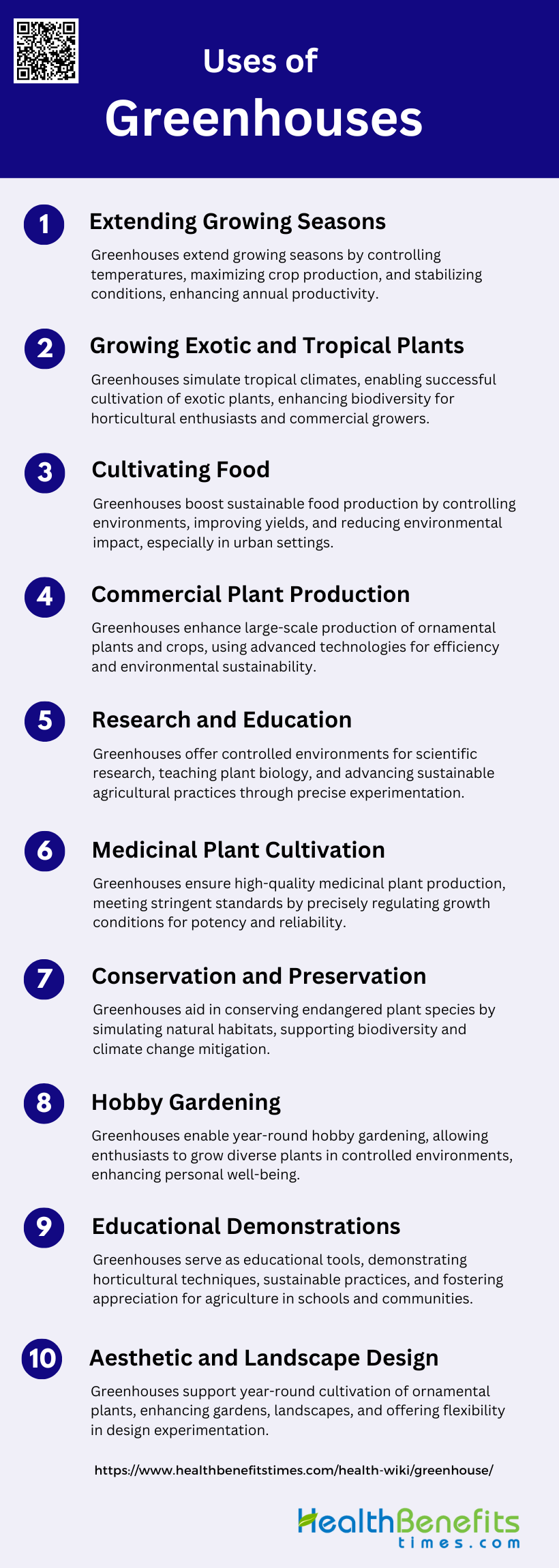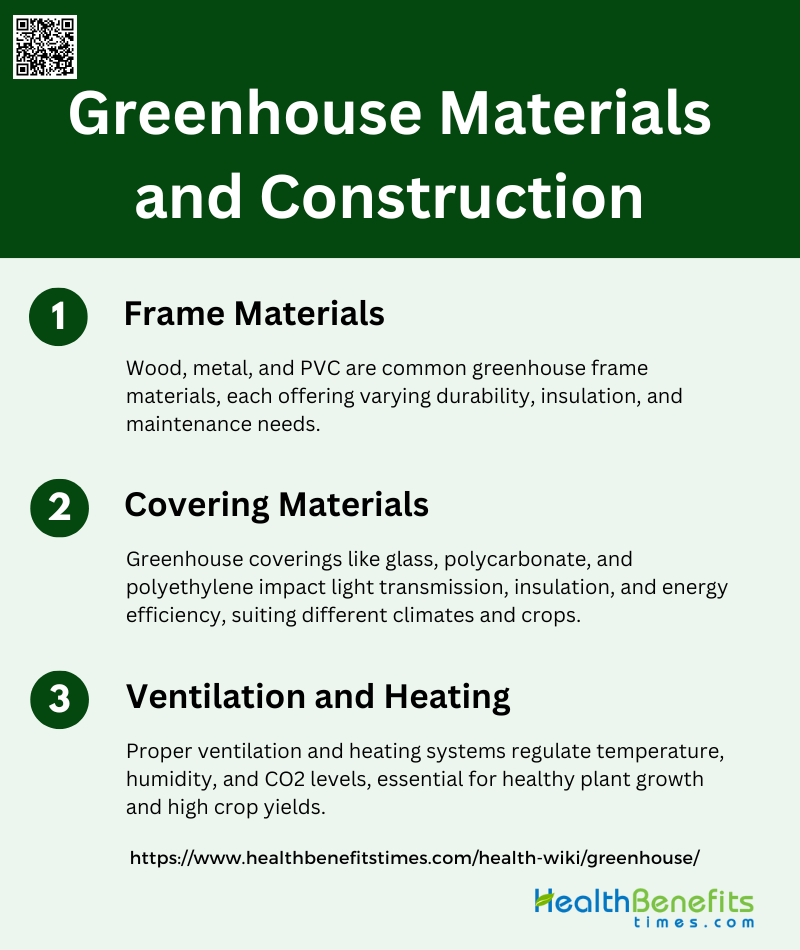A greenhouse is a structure designed to create a controlled environment for plant growth by regulating temperature, humidity, and light. Typically made of glass or transparent materials, greenhouses trap solar energy, creating a warm and stable climate inside that is conducive to plant cultivation, regardless of external weather conditions. This setup allows for the extension of growing seasons and the cultivation of plants that might not thrive in the local climate. Greenhouses play a crucial role in agriculture by enhancing productivity and enabling the growth of a diverse range of crops. They are also instrumental in research and experimentation with plant species, providing a controlled setting to study plant responses to various environmental conditions.
Types of Greenhouses
Greenhouses come in various types, each designed to meet specific needs and environmental conditions. Understanding the different types of greenhouses can help you choose the best one for your gardening or agricultural needs. Below is a list of the most common types of greenhouses and their unique features:
1. Lean-to Greenhouses
Lean-to greenhouses are structures that are attached to an existing building, utilizing one of the building’s walls as one of the greenhouse walls. This design is ideal for small spaces and urban gardening, as it maximizes the use of available space and can share heat with the adjoining building. The main advantage of lean-to greenhouses is their cost-effectiveness and ease of access to utilities like water and electricity from the main building. However, they are limited in size and can suffer from uneven light distribution, which may affect plant growth.
2. Quonset Greenhouses
Quonset greenhouses feature a semicircular, hoop-like structure made from metal or PVC pipes covered with plastic film or polycarbonate panels. This design is highly efficient in terms of material use and provides excellent light diffusion, making it ideal for growing a variety of crops year-round. Quonset greenhouses are particularly effective in capturing solar energy, which is beneficial in colder climates. However, they may require additional heating in extremely cold conditions and can be less stable in high winds compared to other designs.
3. Gothic Arch Greenhouses
Gothic arch greenhouses have a pointed arch shape, which allows for better snow shedding and wind resistance compared to Quonset greenhouses. This design is particularly useful in regions with heavy snowfall. The steep roof angle also enhances light penetration, making it suitable for a wide range of crops. The main advantages include durability and efficient use of space. However, the construction costs can be higher due to the complexity of the design, and they may require more structural support.
4. A-Frame Greenhouses
A-frame greenhouses are characterized by their triangular shape, resembling the letter “A.” This design is simple and cost-effective, making it a popular choice for hobbyists and small-scale growers. The steep roof allows for good light penetration and easy snow shedding. However, the vertical walls can limit the growing space, and the structure may not be as stable in high winds. A-frame greenhouses are best suited for regions with moderate climates and for growing plants that do not require a lot of vertical space.
5. Glass Greenhouses
Glass greenhouses are traditional structures made with glass panels, offering excellent light transmission and a visually appealing aesthetic. They are ideal for growing high-value crops and for use in botanical gardens. The main advantages include durability and superior light quality, which can enhance plant growth. However, glass greenhouses are expensive to build and maintain, and they require robust structural support to withstand weather conditions. They are also less energy-efficient compared to modern materials like polycarbonate.
6. Plastic Film Greenhouses
Plastic film greenhouses use polyethylene or other plastic films as the covering material. This design is cost-effective and easy to construct, making it popular for commercial and small-scale farming. The plastic film provides good light diffusion and can be easily replaced when damaged. However, plastic film greenhouses have a shorter lifespan compared to glass or polycarbonate structures and may require frequent maintenance. They are ideal for seasonal use and for growing a wide range of crops.
7. Polycarbonate Greenhouses
Polycarbonate greenhouses use polycarbonate panels, which are lightweight, durable, and provide excellent insulation. This design is energy-efficient and can withstand impact loads, making it suitable for regions with harsh weather conditions. Polycarbonate greenhouses offer good light diffusion and are less prone to breakage compared to glass. However, they can be more expensive than plastic film greenhouses and may require specialized construction techniques. They are ideal for year-round growing and for crops that require stable environmental conditions.
8. Cold Frame Greenhouses
Cold frame greenhouses are simple, low-to-the-ground structures that use transparent covers to protect plants from cold weather. They are typically used to extend the growing season by providing a microclimate that is warmer than the surrounding environment. Cold frames are easy to construct and can be made from various materials, including wood and plastic. The main advantages include low cost and ease of use. However, they offer limited space and are not suitable for large-scale production. They are ideal for starting seedlings and for growing cold-tolerant crops.
9. Shade House Greenhouses
Shade house greenhouses use shade cloth or netting to provide partial protection from the sun, making them ideal for growing shade-loving plants and for protecting crops from excessive heat. This design is particularly useful in hot climates where full sun exposure can be detrimental to plant health. The main advantages include reduced water evaporation and protection from pests. However, shade houses do not provide protection from cold weather and are not suitable for year-round growing. They are best used for specific crops and during the hottest months of the year.
10. Solar Greenhouses
Solar greenhouses are designed to maximize the use of solar energy for heating and lighting, making them highly energy-efficient. They often incorporate features like thermal mass, insulated north walls, and optimized orientation to capture and store solar energy. This design is ideal for growing crops in cold climates and for reducing energy costs. The main advantages include reduced reliance on external heating and the ability to grow crops year-round. However, the initial construction costs can be high, and the design may require careful planning and maintenance to achieve optimal performance.
Uses of Greenhouses
Greenhouses serve a variety of purposes, from extending the growing season to providing a controlled environment for plant cultivation. They are essential for both hobbyist gardeners and commercial farmers. Below is a list of common uses for greenhouses and their benefits.
1. Extending Growing Seasons
Greenhouses play a crucial role in extending the growing seasons of various crops by creating a controlled environment that mitigates the effects of adverse weather conditions. By utilizing advanced technologies such as thermal energy accumulation and automated climate control systems, greenhouses can maintain optimal temperatures and humidity levels throughout the year. For instance, research has shown that the use of gravel thermal mass in greenhouses can stabilize temperatures and extend the vegetation period by approximately 20 days, even under fluctuating outdoor conditions. This capability allows for continuous crop production, thereby maximizing the use of greenhouse facilities and increasing annual productivity.
2. Growing Exotic and Tropical Plants
Greenhouses provide an ideal environment for cultivating exotic and tropical plants that require specific climatic conditions not naturally available in many regions. By controlling temperature, humidity, and light, greenhouses can simulate the natural habitats of these plants, ensuring their growth and development. Advanced technologies such as light-emitting diode (LED) lighting and automated climate control systems further enhance the ability to grow these plants successfully. This controlled environment allows for the cultivation of a diverse range of exotic species, contributing to biodiversity and offering unique opportunities for horticultural enthusiasts and commercial growers alike.
3. Cultivating Food
Greenhouses are essential for sustainable food production, offering a controlled environment that enhances crop yields and quality. By utilizing technologies such as hydroponics and photovoltaic systems, greenhouses can produce fresh vegetables and fruits with improved energy efficiency. For example, rooftop greenhouses in urban areas have been shown to improve the food supply chain by producing vegetables in unused spaces, thereby reducing the environmental impact and diversifying the food supply. The ability to control environmental parameters such as light, temperature, and humidity ensures stable and high-quality food production throughout the year.
4. Commercial Plant Production
Commercial plant production benefits significantly from greenhouse cultivation due to the ability to control environmental conditions and utilize advanced technologies. Greenhouses enable the production of high-quality ornamental plants, vegetables, and fruits on a large scale, meeting market demands efficiently. Automation systems for water and nutrient management, along with the use of renewable energy sources, enhance productivity and sustainability. The integration of photovoltaic technologies, for instance, reduces energy consumption while maintaining optimal growing conditions, making commercial greenhouse operations more economically viable and environmentally friendly.
5. Research and Education
Greenhouses serve as vital facilities for research and education, providing controlled environments for scientific experiments and learning. They are used in schools to teach students about plant biology, ecology, and the importance of sustainable agriculture. Research institutions utilize greenhouses to study plant growth, disease resistance, and the effects of various environmental factors on crops. Advanced technologies such as automated climate control and hydroponic systems enable precise experimentation and data collection, contributing to scientific advancements in horticulture and agriculture.
6. Medicinal Plant Cultivation
The cultivation of medicinal plants in greenhouses ensures the production of high-quality, potent herbs used in pharmaceuticals and traditional medicine. Controlled environments allow for the precise regulation of factors such as light, temperature, and humidity, which are crucial for the growth and potency of medicinal plants. Research has shown that greenhouses can optimize the growing conditions for various medicinal species, ensuring consistent and reliable yields. This controlled cultivation is essential for meeting the stringent quality standards required for medicinal plant production.
7. Conservation and Preservation
Greenhouses play a significant role in the conservation and preservation of endangered plant species. By providing a controlled environment, greenhouses can simulate the natural habitats of rare and endangered plants, ensuring their survival and propagation. This is particularly important for species that are threatened by habitat loss and climate change. Advanced technologies such as automated climate control and specialized lighting systems enhance the ability to create optimal growing conditions for these plants, contributing to biodiversity conservation efforts.
8. Hobby Gardening
Hobby gardening in greenhouses allows individuals to grow a variety of plants, including vegetables, flowers, and herbs, in a controlled environment. This practice is popular among gardening enthusiasts who seek to extend their growing seasons and cultivate plants that may not thrive in their local climate. Mini greenhouses are particularly popular for hobby gardening, providing a manageable space for personal use. These structures offer an opportunity for individuals to engage in gardening year-round, enhancing their well-being and providing fresh produce for personal consumption.
9. Educational Demonstrations
Greenhouses are valuable tools for educational demonstrations, showcasing various horticultural techniques and sustainable practices. They are used in schools and community centers to teach students and the public about plant biology, ecology, and the importance of sustainable agriculture. Hands-on experiences in greenhouses help learners understand the principles of plant growth, the impact of environmental factors, and the benefits of advanced cultivation technologies. These educational demonstrations foster a greater appreciation for agriculture and encourage the adoption of sustainable practices.
10. Aesthetic and Landscape Design
Greenhouses contribute to aesthetic and landscape design by providing a space for cultivating ornamental plants and flowers. These structures allow for the year-round growth of a wide variety of plants, enhancing the beauty of gardens and landscapes. Advanced technologies such as LED lighting and automated climate control systems ensure optimal growing conditions, resulting in high-quality ornamental plants. Greenhouses also offer the flexibility to experiment with different plant species and design concepts, making them valuable assets for landscape architects and gardening enthusiasts.
Protection against Pests and Harsh Weather
Factors to Consider When Selecting a Greenhouse
When selecting a greenhouse, several factors must be considered to ensure optimal plant growth and pest management. Climate is a crucial factor, as it influences both plant productivity and pest dynamics. For instance, temperature and humidity levels can affect the flight activity of pests and their biological control agents, thereby impacting the efficacy of pest management strategies. Space availability is another important consideration, as it determines the type and size of the greenhouse that can be installed. Smaller spaces may be more suited to home gardening setups, while larger areas can accommodate commercial production. Budget constraints also play a significant role, as the cost of setting up and maintaining a greenhouse can vary widely. While chemical pest control is often inexpensive, the development and application of biological control methods have shown significant promise and can be cost-effective in the long run.
Matching Greenhouse Types to Specific Uses
Different types of greenhouses are suited to various specific uses, such as home gardening, commercial production, and specialized crops. For home gardening, smaller, less expensive greenhouses that offer basic climate control may be sufficient. These setups can benefit from integrated pest management (IPM) strategies that combine biological and chemical controls to manage pests effectively. For commercial production, larger greenhouses with advanced climate control systems are often necessary to ensure year-round production and high-quality yields. These greenhouses can employ sophisticated IPM programs that utilize natural enemies for pest control, reducing the need for and promoting a cleaner environment. Specialized crops, such as ornamental plants, may require greenhouses with specific climate conditions to prevent pest infestations and maintain aesthetic quality. In such cases, the use of insect-proof screening and other protective measures can be crucial.
Greenhouse Materials and Construction
The materials and construction methods used in building greenhouses significantly impact their efficiency, durability, and cost. Choosing the right materials can enhance the greenhouse’s ability to maintain optimal growing conditions. Below is a list of common greenhouse materials and construction techniques.
1. Frame Materials
Wood, metal, and PVC are common materials used for greenhouse frames, each with its own advantages and disadvantages. Wood is a traditional choice, offering good insulation and ease of construction, but it is susceptible to rot and pests, requiring regular maintenance. Metal frames, typically made from aluminum or galvanized steel, are durable and can support heavy loads, but they are prone to rust and can be expensive. PVC is lightweight, resistant to corrosion, and easy to assemble, making it a cost-effective option. However, it may not be as strong as metal and can degrade under prolonged exposure to UV light.
2. Covering Materials
Greenhouse covering materials significantly impact the internal microclimate and energy efficiency. Glass provides excellent light transmission and durability, making it ideal for long-term use, but it is heavy and expensive. Polycarbonate offers a balance between durability and light diffusion, with good thermal insulation properties, making it suitable for both hot and cold seasons. Polyethylene film is the most economical and easy to install, but it has a shorter lifespan and can lead to significant temperature fluctuations inside the greenhouse. Each material’s performance varies with environmental conditions and specific crop requirements.
3. Ventilation and Heating
Proper ventilation and heating are crucial for maintaining optimal growing conditions in a greenhouse. Effective air circulation helps regulate temperature, humidity, and CO2 levels, which are essential for plant health and growth. Common ventilation systems include roof vents, side vents, and exhaust fans, which help remove excess heat and humidity. Heating systems, such as electric heaters, gas heaters, and thermal screens, are used to maintain a stable temperature during colder months. The integration of these systems ensures a controlled environment, reducing the risk of plant diseases and improving overall crop yield.
Maintenance and Care of Greenhouse
Routine Greenhouse Maintenance
Routine maintenance is essential for a healthy and productive greenhouse environment. Regular cleaning is crucial to prevent the buildup of algae, mold, and pests. This includes washing the greenhouse walls and roof to maximize light penetration and sanitizing pots and trays. Repairs should be promptly addressed, such as fixing leaks, replacing broken glass or plastic panels, and ensuring structural integrity. Monitoring systems, like temperature and humidity controls, should be checked frequently to ensure they are functioning correctly. Regular maintenance not only extends the lifespan of the greenhouse but also creates optimal conditions for plant growth.
Seasonal Care Tips
Seasonal care is vital to adapt the greenhouse environment to changing weather conditions. Preparing for winter involves insulating the greenhouse to retain heat, using bubble wrap or thermal screens, and ensuring heating systems are operational. In contrast, summer care focuses on cooling, which can be achieved by installing shade cloths, using ventilation systems, and ensuring adequate watering to prevent plant stress. It’s also important to adjust plant placement for optimal light exposure and to monitor for pests that may thrive in seasonal conditions. These adjustments help maintain a stable environment for plants year-round.





